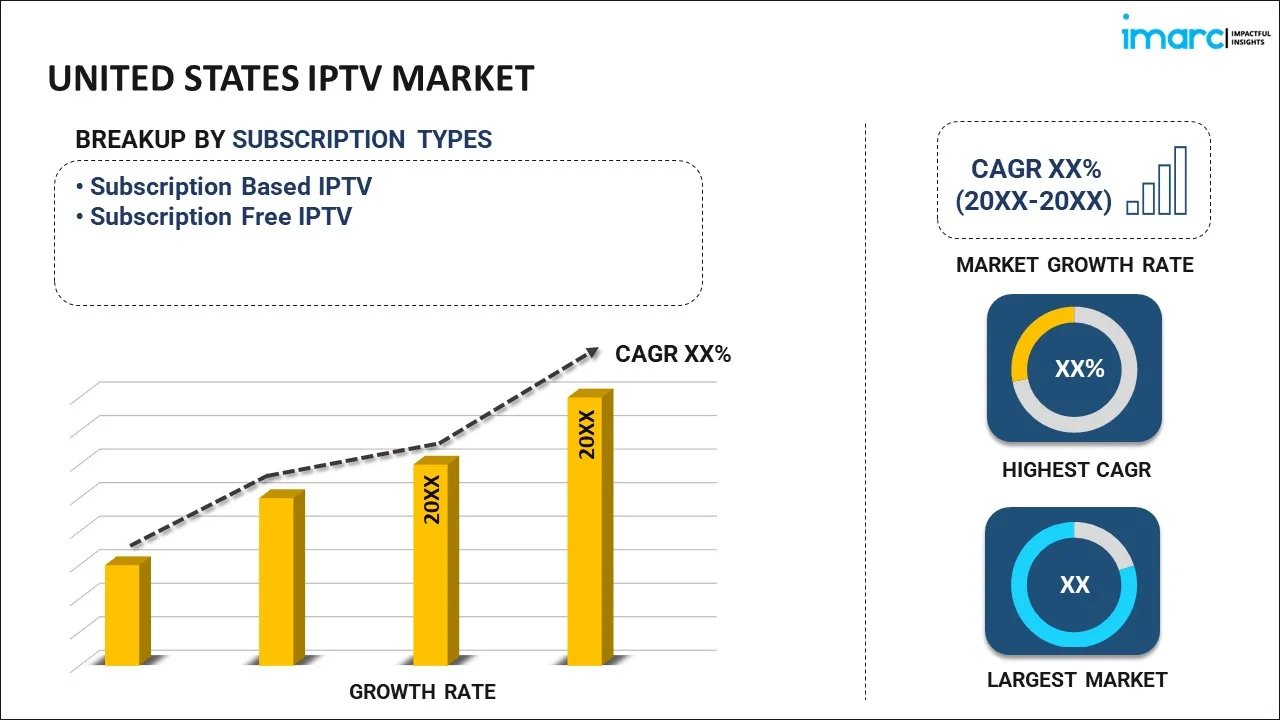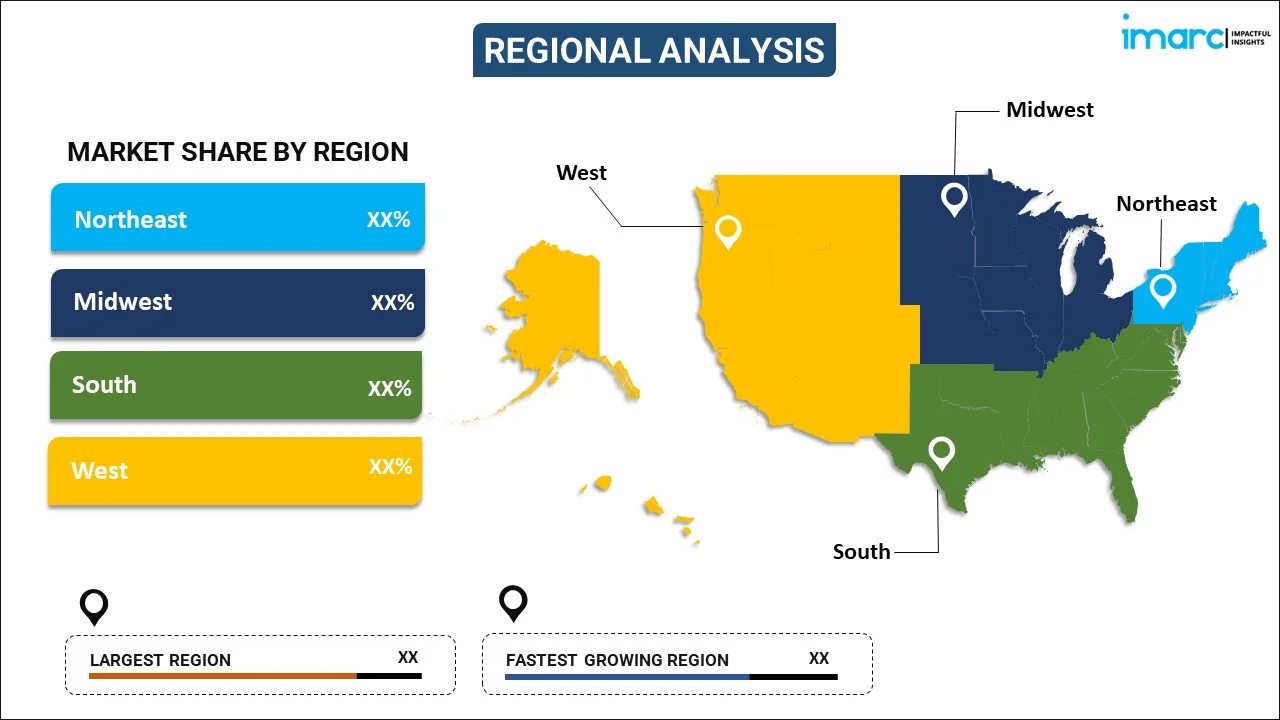
United States IPTV Market Report by Subscription Type (Subscription Based IPTV, Subscription Free IPTV), Transmission Type (Wired, Wireless), Device Type (Smartphones and Tablets, Smart TVs, PCs, and Others), Streaming Type (Video IPTV, Non-Video IPTV), Service Type (In-House Service, Managed Service), End User (Residential, Enterprises), and Region 2025-2033
Market Overview:
United States IPTV market size reached USD 32.6 Billion in 2024. Looking forward, IMARC Group expects the market to reach USD 106.7 Billion by 2033, exhibiting a growth rate (CAGR) of 12.4% during 2025-2033. The ongoing technological advancements, such as the development of better video compression techniques and improvements in streaming protocols, which have enhanced the quality of IPTV services, are driving the market.
|
Report Attribute
|
Key Statistics
|
|---|---|
|
Base Year
|
2024 |
|
Forecast Years
|
2025-2033
|
|
Historical Years
|
2019-2024
|
| Market Size in 2024 | USD 32.6 Billion |
| Market Forecast in 2033 | USD 106.7 Billion |
| Market Growth Rate (2025-2033) | 12.4% |
IPTV, or internet protocol television, is a digital television service delivered over the internet instead of traditional cable or satellite means. It allows users to stream TV channels and on-demand content through internet connections, providing a more flexible and customizable viewing experience. IPTV uses internet protocol (IP) technology to transmit video content in the form of data packets. Viewers can access IPTV services on various devices like smart TVs, computers, smartphones, and set-top boxes. Unlike traditional broadcasting, IPTV enables interactive features such as video on demand (VOD), time-shifted media, and multimedia communication. This technology has gained popularity for its on-demand accessibility, diverse content options, and the ability to tailor programming to individual preferences. IPTV is a significant component of the evolving landscape of digital entertainment and has transformed the way people consume television content.
United States IPTV Market Trends:
The IPTV market in the United States is experiencing robust growth, primarily propelled by several key drivers. Firstly, the increasing penetration of high-speed internet regionally has paved the way for seamless content streaming, bolstering the demand for IPTV services. Moreover, the rising trend of cord-cutting, driven by consumer preferences for personalized and on-demand content, is steering individuals toward IPTV as an alternative to traditional cable and satellite television. Furthermore, advancements in technology, such as the widespread adoption of 5G networks, are enhancing the overall quality of IPTV streaming, fostering a more immersive viewing experience. The convergence of telecommunications and broadcasting is another pivotal factor, with telecom operators expanding their service portfolios to include IPTV offerings, thereby driving market growth. Additionally, the accelerated shift towards digital entertainment, with lockdowns and social distancing measures, is prompting a surge in at-home media consumption. This change in consumer behavior has not only boosted IPTV subscriptions but has also encouraged content providers to diversify their offerings, meeting the evolving demands of a digitally connected audience. In conclusion, the IPTV market in the United States is propelled by a confluence of factors, including technological advancements, changing consumer preferences, and the regional shift towards digital content consumption, creating a fertile ground for sustained growth in the foreseeable future.
United States IPTV Market Segmentation:
IMARC Group provides an analysis of the key trends in each segment of the market, along with forecasts at the country level for 2025-2033. Our report has categorized the market based on subscription type, transmission type, device type, streaming type, service type, and end user.
Subscription Type Insights:

- Subscription Based IPTV
- Subscription Free IPTV
The report has provided a detailed breakup and analysis of the market based on the subscription type. This includes subscription based IPTV and subscription free IPTV.
Transmission Type Insights:
- Wired
- Wireless
A detailed breakup and analysis of the market based on the transmission type have also been provided in the report. This includes wired and wireless.
Device Type Insights:
- Smartphones and Tablets
- Smart TVs
- PCs
- Others
The report has provided a detailed breakup and analysis of the market based on the device type. This includes smartphones and tablets, smart TVs, PCs, and others.
Streaming Type Insights:
- Video IPTV
- Non-Video IPTV
A detailed breakup and analysis of the market based on the streaming type have also been provided in the report. This includes video IPTV and non-video IPTV.
Service Type Insights:
- In-House Service
- Managed Service
The report has provided a detailed breakup and analysis of the market based on the service type. This includes in-house service and managed service.
End User Insights:
- Residential
- Enterprises
A detailed breakup and analysis of the market based on the end user have also been provided in the report. This includes residential and enterprises.
Regional Insights:

- Northeast
- Midwest
- South
- West
The report has also provided a comprehensive analysis of all the major regional markets, which include Northeast, Midwest, South, and West.
Competitive Landscape:
The market research report has also provided a comprehensive analysis of the competitive landscape in the market. Competitive analysis such as market structure, key player positioning, top winning strategies, competitive dashboard, and company evaluation quadrant has been covered in the report. Also, detailed profiles of all major companies have been provided.
United States IPTV Market Report Coverage:
| Report Features | Details |
|---|---|
| Base Year of the Analysis | 2024 |
| Historical Period | 2019-2024 |
| Forecast Period | 2025-2033 |
| Units | Billion USD |
| Scope of the Report | Exploration of Historical Trends and Market Outlook, Industry Catalysts and Challenges, Segment-Wise Historical and Future Market Assessment:
|
| Subscription Types Covered | Subscription Based IPTV, Subscription Free IPTV |
| Transmission Types Covered | Wired, Wireless |
| Device Types Covered | Smartphones and Tablets, Smart TVs, PCs, Others |
| Streaming Types Covered | Video IPTV, Non-Video IPTV |
| Service Types Covered | In-House Service, Managed Service |
| End Users Covered | Residential, Enterprises |
| Regions Covered | Northeast, Midwest, South, West |
| Customization Scope | 10% Free Customization |
| Post-Sale Analyst Support | 10-12 Weeks |
| Delivery Format | PDF and Excel through Email (We can also provide the editable version of the report in PPT/Word format on special request) |
Key Questions Answered in This Report:
- How has the United States IPTV market performed so far and how will it perform in the coming years?
- What has been the impact of COVID-19 on the United States IPTV market?
- What is the breakup of the United States IPTV market on the basis of subscription type?
- What is the breakup of the United States IPTV market on the basis of transmission type?
- What is the breakup of the United States IPTV market on the basis of device type?
- What is the breakup of the United States IPTV market on the basis of streaming type?
- What is the breakup of the United States IPTV market on the basis of service type?
- What is the breakup of the United States IPTV market on the basis of end user?
- What are the various stages in the value chain of the United States IPTV market?
- What are the key driving factors and challenges in the United States IPTV?
- What is the structure of the United States IPTV market and who are the key players?
- What is the degree of competition in the United States IPTV market?
Key Benefits for Stakeholders:
- IMARC’s industry report offers a comprehensive quantitative analysis of various market segments, historical and current market trends, market forecasts, and dynamics of the United States IPTV market from 2019-2033.
- The research report provides the latest information on the market drivers, challenges, and opportunities in the United States IPTV market.
- Porter's five forces analysis assist stakeholders in assessing the impact of new entrants, competitive rivalry, supplier power, buyer power, and the threat of substitution. It helps stakeholders to analyze the level of competition within the United States IPTV industry and its attractiveness.
- Competitive landscape allows stakeholders to understand their competitive environment and provides an insight into the current positions of key players in the market.
Need more help?
- Speak to our experienced analysts for insights on the current market scenarios.
- Include additional segments and countries to customize the report as per your requirement.
- Gain an unparalleled competitive advantage in your domain by understanding how to utilize the report and positively impacting your operations and revenue.
- For further assistance, please connect with our analysts.
 Request Customization
Request Customization
 Speak to an Analyst
Speak to an Analyst
 Request Brochure
Request Brochure
 Inquire Before Buying
Inquire Before Buying




.webp)




.webp)












